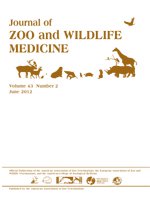Information onreference blood values in the literature is lacking for many wild rodents. In this study, comprehensive reference intervals (RIs) for a wide range of analytes from 101 healthy free-ranging nutria were determined. Animals were captured in Buenos Aires, Argentina (37°50′S, 57°34′W), and southward (38°60′S, 58°23′W), encompassing major biotopes of agricultural pampas with dunes and grassland steppes on the east coast. Traps were set at locations with high-density nutria populations (i.e., those areas that showed signs of movement, territorial marking, or feeding activities). Although the small sample size limits the interpretation of these findings, RIs were determined by a robust method using the central 95th percentile. In nutria, the RI range varied greatly for the leukocyte differentials, with mature neutrophils: 3,907–5,544/μl for females and 3,744–5,900/μl for males; band neutrophils: 0–10/μl for females and 3–18/μl for males; lymphocytes: 4,213–5,940/μl for both sexes combined; monocytes: 165–402/μl for both sexes combined; eosinophils: 13–91/μl for females and 108–165/μl for males; and basophils: 0–87/μl for both sexes combined. Platelet concentration was 543–727 × 109/L for both sexes combined. There was also a wide RI range for biochemistry values for some enzymes, such as alkaline phosphatase: 200–399 IU/L for both sexes combined; cholinesterase: 762–1,407 IU/L for females and 763–1,284 IU/L for males; creatine kinase: 182–552 IU/L for females and 162–451 IU/L for males; amylase: 853–1,865 IU/L for females and 779–1,293 IU/L for males; and glucose concentration 120.2–180.6 mg/dl for both sexes combined. Conversely, there was not a wide pooled RI range for calcium: 7.0–11.2 mg/dl; phosphorous: 6.1–9.3 mg/dl; sodium: 133.0–159.0 mEq/L; potassium: 3.0–8.2 mEq/L; chloride: 101.4–143.0 mEq/L; and urea: 11.3–36.8 mg/dl.The red blood cell indices had a narrow range, with mean corpuscular volume: 84.0 −102.5 fl and mean corpuscular hemoglobin concentration: 18.2–28.8 g/dl, and which was most likely due to strict physiologic controls. The results from this study were similar to those previously reported for farmed nutria.
How to translate text using browser tools
1 June 2012
HEMATOLOGY AND SERUM BIOCHEMISTRY OF FREE-RANGING NUTRIA (MYOCASTOR COYPUS)
Pablo E Martino,
Sandra M Aráuz,
Fernando Anselmino,
Cecilia C Cisterna,
Maria P Silvestrini,
Santiago Corva,
Federico A Hozbor
ACCESS THE FULL ARTICLE
hematology
Myocastor coypus
nutria
serum biochemistry





